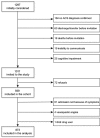Sex differences in presenting symptoms of acute coronary syndrome: the EPIHeart cohort study
- PMID: 29476027
- PMCID: PMC5855399
- DOI: 10.1136/bmjopen-2017-018798
Sex differences in presenting symptoms of acute coronary syndrome: the EPIHeart cohort study
Abstract
Objectives: Prompt diagnosis of acute coronary syndrome (ACS) remains a challenge, with presenting symptoms affecting the diagnosis algorithm and, consequently, management and outcomes. This study aimed to identify sex differences in presenting symptoms of ACS.
Design: Data were collected within a prospective cohort study (EPIHeart).
Setting: Patients with confirmed diagnosis of type 1 (primary spontaneous) ACS who were consecutively admitted to the Cardiology Department of two tertiary hospitals in Portugal between August 2013 and December 2014.
Participants: Presenting symptoms of 873 patients (227 women) were obtained through a face-to-face interview.
Outcome measures: Typical pain was defined according to the definition of cardiology societies. Clusters of symptoms other than pain were identified by latent class analysis. Logistic regression was used to quantify differences in presentation of ACS symptoms by sex.
Results: Chest pain was reported by 82% of patients, with no differences in frequency or location between sexes. Women were more likely to feel pain with an intensity higher than 8/10 and this association was stronger for patients aged under 65 years (interaction P=0.028). Referred pain was also more likely in women, particularly pain referred to typical and atypical locations simultaneously. The multiple symptoms cluster, which was characterised by a high probability of presenting with all symptoms, was almost fourfold more prevalent in women (3.92, 95% CI 2.21 to 6.98). Presentation with this cluster was associated with a higher 30-day mortality rate adjusted for the GRACE V.2.0 risk score (4.9% vs 0.9% for the two other clusters, P<0.001).
Conclusions: While there are no significant differences in the frequency or location of pain between sexes, women are more likely to feel pain of higher intensity and to present with referred pain and symptoms other than pain. Knowledge of these ACS presentation profiles is important for health policy decisions and clinical practice.
Keywords: acute coronary syndrome; diagnosis; sex; women.
© Article author(s) (or their employer(s) unless otherwise stated in the text of the article) 2018. All rights reserved. No commercial use is permitted unless otherwise expressly granted.
Conflict of interest statement
Competing interests: All authors have completed the ICMJE uniform disclosure form at www.icmje.org/coi_disclosure.pdf and declare: all authors had financial support through grants from the Foundation for Science and Technology (FCT; Portuguese Ministry of Science, Technology and Higher Education) and from Unidade de Investigação em Epidemiologia—Instituto de Saúde Pública da Universidade do Porto. No financial relationships with any organisations that might have an interest in the submitted work in the previous 3 years; no other relationships or activities that could appear to have influenced the submitted work.
Figures
References
-
- Mendis S. Global Status Report on noncommunicable diseases 2014 report. Geneva, Switzerland: World Health Organization, 2014. - PubMed
Publication types
MeSH terms
LinkOut - more resources
Full Text Sources
Other Literature Sources
Medical

